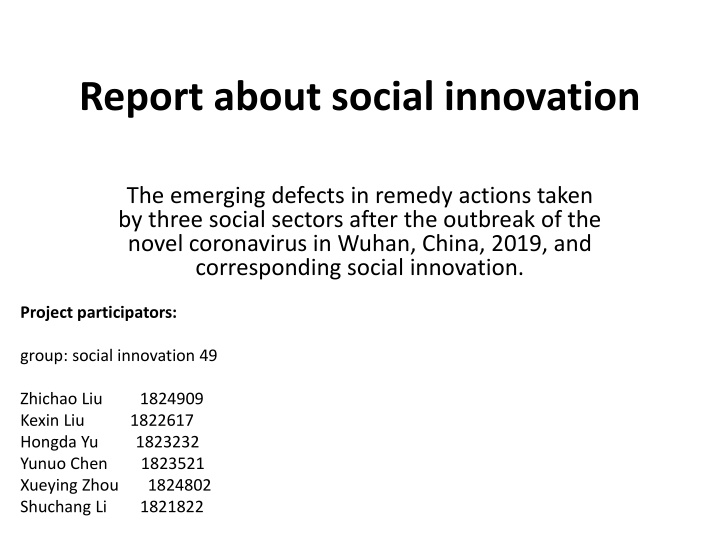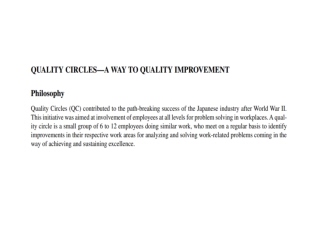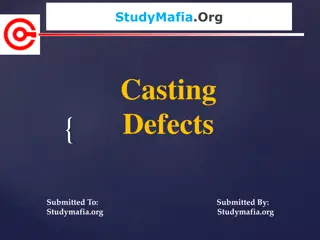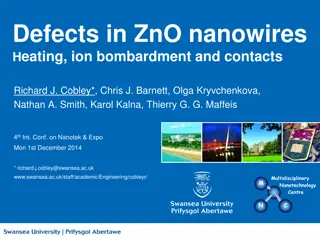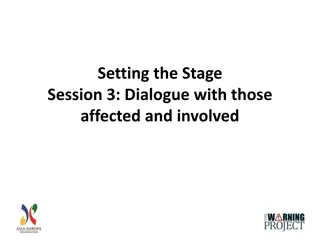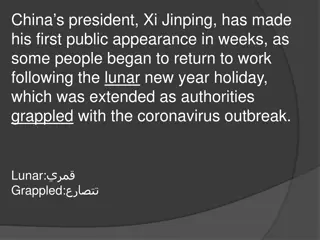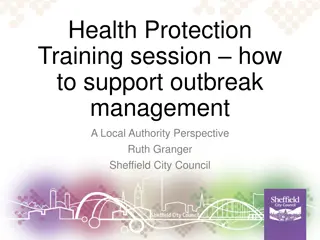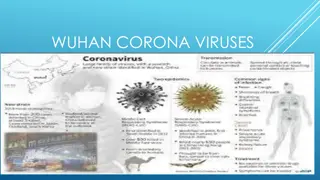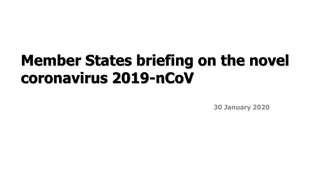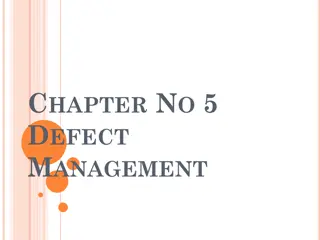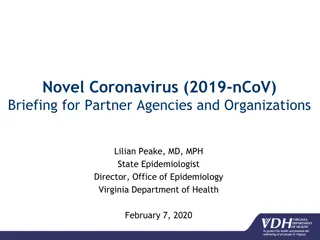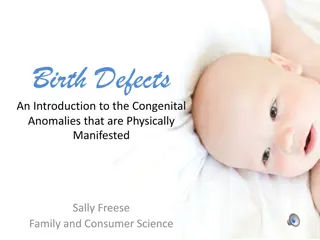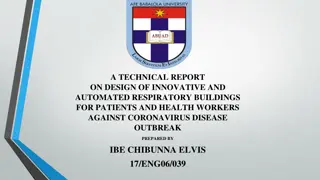Addressing Emerging Defects in Social Sectors Post Novel Coronavirus Outbreak in Wuhan: A Study on Social Innovation
The study delves into the emerging defects in remedial actions taken by social sectors - governance, media, and healthcare - post the COVID-19 outbreak in Wuhan. It highlights issues like insufficient medical supplies reserve, lack of coordinated information dissemination by media, and gaps in the healthcare system. The study proposes potential solutions to rectify these shortcomings and enhance social innovation in response to crisis situations.
Download Presentation

Please find below an Image/Link to download the presentation.
The content on the website is provided AS IS for your information and personal use only. It may not be sold, licensed, or shared on other websites without obtaining consent from the author.If you encounter any issues during the download, it is possible that the publisher has removed the file from their server.
You are allowed to download the files provided on this website for personal or commercial use, subject to the condition that they are used lawfully. All files are the property of their respective owners.
The content on the website is provided AS IS for your information and personal use only. It may not be sold, licensed, or shared on other websites without obtaining consent from the author.
E N D
Presentation Transcript
Report about social innovation The emerging defects in remedy actions taken by three social sectors after the outbreak of the novel coronavirus in Wuhan, China, 2019, and corresponding social innovation. Project participators: group: social innovation 49 Zhichao Liu 1824909 Kexin Liu 1822617 Hongda Yu 1823232 Yunuo Chen 1823521 Xueying Zhou 1824802 Shuchang Li 1821822
Introduction The outbreak of the novel coronavirus in China 2019 can not only be treated as a human-caused disaster but also a test for human society and a mirror which reflects the potential weaknesses hidden in our social system. Thus, we processed our study research and have found several emerging defects in remedy actions taken by three social sectors, including social governance, media, and medical system, after the outbreak of the novel coronavirus in Wuhan, China, 2019. Moreover, we provided correspondingly and possibly efficacious solutions.
Outline Social governance aspect >problem one: Medical supplies reserve >Problem two: The delivery of medical supplies >Problem three: The price control of medical equipment >Problem four: The distribution of medical supplies Media aspect >Problem one: Diverse Information Confused the Public >Problem two: Shuanghuanglian Event Medical system aspect >Problem one: Institutional Improvements and Policy Adjustments >Problem two: Horizontal adjustment for Center of Disease Control (CDC) >Problem three: Innovation and In-depth Development of Health Industry >Problem three: Innovation and In-depth Development of Health Industry Conclusion
Defects in social governance aspect Problem one: Medical supplies reserve Background: The shortage of medical supplies reflects insufficient national medical reserves. The NCP epidemic happened during the Chinese traditional spring festival, which means most of the industries were shut down and workers were absent. This situation caused a huge gap between supply and demand. In February 24, the official media of Wuhan issued a statement about emergency aids, which pointed out that most of hospitals were lack of supplies and the existing goods only can last for three to five days (Ke, 2020). Moreover, many hospitals directly publish posters through official WeChat and openly solicit medical supplies such as masks and protective clothing from the society (Ke, 2020). However, due to the absence of workers and isolation policy to many cities, many supplies which were sent to Hubei were blocked in the last kilometer . Since 1997, The State Council formally issued the "State Council's Notice on Reforming and Strengthening the Management of the National Pharmaceutical Reserve", which states that the national pharmaceutical reserve is used to ensure the timely and sufficient supply of medicines and medical equipment when major emergencies such as disasters and epidemics occur (The medical material reserve system needs to be implemented urgently, 2020). However, this reserve system seems to be immature for now. The mean reasons can be concluded as the cost of producing and stock are very high. If the medicine expires, then the loss will be borne by the company. In that case, stock companies are facing a dilemma, if a large number of high-priced medicines were purchased, and the losses will be huge once the epidemic is resolved and this situation once happened in 2003 (The medical material reserve system needs to be implemented urgently, 2020). Although government set up an emergency management system in 2018, it is still immature for now. For example, the routine stocks are masks and medicines rather than protective suits (How to guarantee the supply of medical supplies, 2020). In the past, this system worked smoothly. Especially in the era of unclear information, the shortage of a certain area is unknown, and it will still be resolved by the higher administrative unit in the end. But what is special about the NCP epidemic is that the speed of the spread is too fast, which tests the speed of administration. The speed of Internet information exchange combined with the enthusiasm and action of citizens, may run faster than the administrative speed (How to guarantee the supply of medical supplies, 2020).
Enhancing follow-up production efficiency, establishing a dynamic inventory system and improving medical system. Innovation Against the problem we mentioned above, we should focus on enhancing follow-up production efficiency, establishing a dynamic inventory system and improving medical system. Because of the huge cost of medical equipment inventories, the best way to reduce the gap between demand and supply could be increasing the follow-up production efficiency. At the same time, establishing a dynamic inventory system is also very important. A dynamic inventory system including focus on the market change of materials to decrease cost, reduce reaction time to the epidemic and improve production flexibility. Moreover, we should ensure workers who plays an important role in production recovery return. The number of production machines is very important. Certain encouragement measures are necessary to make enterprises assured to produce a number of masks, protective clothing and other materials without worrying about the decline in demand after the epidemic. In addition, the Bureau of Quality and Technical Supervision should strengthen control over the quality of masks at the very moment of the epidemic to ensure production in accordance with quality and quantity.
Problem two: The delivery of medical supplies Background: The delivery of medical equipment is inefficient. According to the announcement of transportation department, in January 30, 11042 green passageways for emergency defense supplies highways have been deployed in various places, which gives non-stop, no inspection and no toll collection priorities to delivery (Aid is not getting into wuhan, 2020). However, the green passageways are insufficient. Some second or third tier city hospitals around Hubei didn t have green passageways, which caused the last kilometer puzzle. Due to the regulation of transportation, those hospitals can only get medical equipments from big cities nearby, like Wuhan. Besides, many transport workers are absent during the festival, which increases the transportation time.
Innovation Making use of technology, open more green tunnel and cooperate with express companies. In China's second- and third-tier cities, the "green channel" can be used to promote the opening of government performance inspections and other methods. In addition, the verification of transportation qualifications and material content related to the "green channel" can be matched with the verification equipment of various cities and provinces through vehicle-mounted Internet of Things equipment through technologies such as the Internet of Things, so that disaster relief materials can quickly pass through the expressway inspection gate And city blockade. For non- governmental logistics companies such as SF, ZTO, YTO, etc., the relevant departments can organize the transportation of express delivery companies to centrally adjust the transportation of animal materials, simplifying the approval of expressway access in various provinces and cities. Regarding the problem that the relevant personnel have not resumed work, the resumption of approval for logistics transportation-related enterprises should be speeded up to speed up the work efficiency of logistics transportation.
Problem Three: The price control of medical equipment Background: One-size-fits-all price restrictions of some medical equipments are not conducive to market development. The Nobel price winner Joseph Eugene Stiglitz have a view that both markets and governments fail, under the conditions of incomplete information or incomplete market, the government should play an important role in correcting market failures, market constraints, and in pursuing social justice (https://www8.gsb.columbia.edu/faculty/jstiglitz/ , 2020). According to the law of demand, while the demand of medical equipment increase rapidly, the price will also increase. In that case, government have limited the price of some goods. The State General Administration of Market Supervision convened a meeting on January 28th, demanding that the market price supervision should be focused on and people's livelihood supplies should be continuously strengthened (https://www8.gsb.columbia.edu/faculty/jstiglitz/, 2020). According to the "Provisions on Administrative Penalties for Illegal Price Acts", it is clearly stipulated that if the price is soared, the retailer will be fined more than 500,000 yuan but less than 3 million RMB (https://www8.gsb.columbia.edu/faculty/jstiglitz/, 2020). However, government should allow price increases to some extent, otherwise, the policy would reduce the motivation of production. Take medical masks as an example, because of the demand increases, the price of some raw materials like cotton and non-woven cloth will also increase. Besides, the delivery and labor cost will also rise. If the price of mask is a fixed value, the market mechanism would be seriously injured, and eventually the producer would dare not produce, and the shortage would be even more serious.
Innovation: Use financial derivatives to maintain the equipment prices, allow appropriate price rising and use big data Price control of raw materials is one of the key links in the entire production (Bouskill and Smith, 2019). Using financial derivatives like option, issue supply options for important materials, and relax financing approval for the purchase of equipment related to material production, conduct risk management for epidemic prevention material production enterprises, and purchase raw materials for masks such as non-woven fabrics through centralized channels to ensure adequate supply of raw materials (Sands et al., 2016). Prices do not rise sharply, reducing the impact of supply and demand. This is a new idea for the futures industry to support epidemic prevention and control work. In terms of price control of materials, appropriate price increases are allowed, and the transaction prices of key materials are required to be publicly disclosed. Transaction prices, information and quantities are open to public supervision. At the same time, the administrative penalties imposed by the supervision are monitored to prevent overcorrection. In addition, you can use tools such as big data to track price trends and provide guidance for government price regulation.
Problem four: The distribution of medical supplies Background: Another problem about supplies is that many medical equipment distributions are uneven and nondisclosure. Because of the national concern about NCP epidemic, the amount of equipment received every-day is very huge, thus some donation hub like Red Cross Society of China Wuhan Branch cannot guaranteed efficient and rapid delivery. Besides, the Wuhan branch is lack of expertise technology assistance (Dong, 2020). The official website of Wuhan branch shows that they have received over 863.94 million RMB donations from society up to February 2 (http:// www.wuhanrc.org.cn/info/1003/2782.htm, 2020). However, we can barely see the total donation amounts and the remaining amounts unless we calculate all the data in the given tables. In that case, many deceptions and omissions would occur.
Innovation: Use block chain technology and set up the material distribution system Using block chain technology as a new application mode (Hasan and Salah, 2018). It has distributed data storage mechanism, point to point communication, consensus and encryption algorithm, which can deal with participating emergency event and provide all parties with a distributed database. It can also be shared but not tampered using cryptographic encryption, to ensure the emergency incident management transparency, fairness and efficiency. The material distribution system assists material distribution, directly connecting the hospital needs with suppliers and donors, reducing the transmission and communication cost, and improving the efficiency of material delivery.
Defects in Media aspect Problem one: Diverse Information Confused the Public Background: The diversity of information released by different social media platform could misunderstood the public. To better engage with this social phenomenon, there are some concepts of three different media system need to be clarified, which includes commercial media, state media, and public media. Firstly, commercial media refers that media texts are created in order to generate revenue and, ultimately, profit for the producing organization (Lacey, 2002). Secondly, state media refers to that media produced by or for the state, over which the state has editorial control (High, 2019). Thirdly, public media refers to media financed in whole or in part by the public and aiming to serve the public interest (High,2019).
Driven by the profit, various key opinion leaders (KOLs) might publish controversial arguments. As for the state media, on account of the Shuanghuanglian incident, the reliability of the state media has already decreased according some comments from the social media platform. For instance, some users made impolite comments and memes under the official account of state media. In addition, the results of one question in the questionnaire indicate that compared with the other two channels of information release (the state media platform and the non-profit organization), most netizens have low trust in we media. To be specific, the question is that ranking the credibility of the following information publishers, which includes, first, National information-publish channels (such as CCTV, People's Daily, etc.), second, a global organization that is independent from parties and marketing interests and serves for the development of the human world, third, we media with high influence. According to the statistical result of our questionnaire, there are 124 of 207 respondents ranked the National information-publish channels as the most creditable information publisher while 99 of 207 respondents ranked the global organization as the second creditable information publisher; 145 of 207 respondents ranked the we media the least creditable information publisher, which indicates that people have low trust in information published by we media. However, we media is deeply involved in daily life, so more control and daily supervision should be applied to the information released by we media under emergency situations.
Innovation: promote more cooperation between official media institutions and social media platforms. Social media and the official media will work together more often (The 8th China news and rule of law academic summit was held in Beijing, 2020). In our hypothesis, we media can more accurately reflect the circumstances when disasters happened because the most authors are the victims or witnesses and they are easy to get primary source, though they might be influenced by different factors. Thus, by cooperating with official media might, to certain extents, could improve the credibility and trueness of it. To be specific, the censorship of social media contents, especially when it is related with the emerging disaster, should be more seriousely and strictly applied. Furthermover, we propose that official media institution should coorperate with social media platforms to select and censor the high-influncial social media contents. Besides, the offcial media institution could give a certification mark to the quantified social media contents, thus, it is a good way to increase the credibility of those efficient social media content.
Problem Two: Shuanghuanglian Event Background: State media released controversial information about one possibly efficacious medicine, causing the shopping spree. The People Daily reported that ShuangHuangLian could suppress the new coronavirus, which was the top trending search on Weibo, triggering a scramble. The problem with this report is that the publisher did not make the necessary scientific interpretation of the original message, nor did he consider the consequences of triggering a scramble in the panic of the epidemic. To explain this phenomenon, we used the Detailed Possibility Model (ELM), which is the most influential theoretical model in analyzing the information processing behavior of consumers. According to ELM model, people have two different paths to process information when receiving messages, one is the central path and the other is the edge path (Yan, 2017). In the central path, the judgment of the public mainly depends on the information content itself, and they will critically consider the quality of information arguments. However, in the marginal path, people mainly rely on perceptual factors to judge, and tend to be influenced by persuasion environment, such as the identity of information release party, so as to change their attitude. Indeed, it is difficult to require every citizen to be able to judge medical research with professional information, which puts a higher demand on the scientific and rigorous attitude of the information providers when they release health-related information. At the same time, considering the serious problem of public opinion in the era of media in China, neither commercial media nor state- controlled media can be completely convincing. Therefore, the idea of establishing a public media platform came out.
Innovation: established a global social media platform. According to Zizek (2020), the establishing public media platform should have the attribute of unbiased and information-driven when disasters in national level occur (such as the outbreak of the novel coronavirus). we propose to the established a global social media platform which, in our hypothesis, could be one credible and authoritative platform to release the accurate information and also can provide people around the world a cross-border chance to communicate about the emerging disaster. The core of the platform is to popularize scientific health information and serve the health of human society. This global social media platform has its feasibility. Firstly, the new media has the characteristic of denationalization and de-territorialization (Curran, 2016). Under that circumstance, it is easy for this platform to provide a global communcation system. Secondly, the development of new media tightly rely on technology, including computer progarmming and algorithms (Huang, 2019). With the 5G technology developing in China, it is convient for establing this platform. In this platform, we will: > Update relevant scientific literature, provide objective suggestion and measures to alleviate the damage of disaster. In addition, all the information updated in this platform will be authoritatively verified by the experts. >Provide a global platform to communicate with people around the world. In this place, people can post video, comments, blog related to the published information by the platform with Auto translation Plug-in, automatically translated, in order to learn more about this emerging disaster thoroughly.
Defects in Medial System Problem one: Inadequate of policy implementation depth Background: The novel coronavirus, which is regarded as a public health-related emergency pushed China into a serious situation. While during 2017, National strategies for universal health have been proposed as the development strategy in the report of the 19th CPC national congress. According to Mu (2019), the professor of Weinan Teacher Collage, the strategy for universal health is a top-level design which has not been implemented well enough to resonate the public health awareness strongly. With the impact of COVID-2019, the problem of detailed institutional deficiency become prominent. In Opinions of state council on implementing the healthy China initiative published in 2019, government confirms that the policy system will be established and the health literacy level will increase steadily, the major infectious diseases be prevented and controlled effectively by 2022. It can be said that national strategies for public health events have been developed, but there are shortcomings in the process of implementation, which are magnified in the outbreak of COVID-2019. Aiming to ease the dilemma of unperfect institution, our group came up with the idea mainly focused on the function of grassroot.
Innovation: Institutional improvements and policy adjustments on the role of grassroots cadres. From the macro perspective, states council take the biosafety and national health strategies into national development issue is a practical and positive top design, while in China's unique political structure, when the top of state proposed a strategy for development, the monitory of the policy implementation in grass root is the significant part of policy effectiveness. In considering the fundamental realities of China, which includes an extreme large amount of population, a wide range of territories are the actual social situation of aging, the leading cadres of the community and residents committees in cities and the village committees should play their roles. Not only in the fight of COVID-2019, but also for the future health China strategy. Community is the smallest unit in residents' life. In the process of realizing the goal of healthy China, the primary thing to do is to make clear responsibility planning. As shown in the hot videos online at the end of January (People daily, 2020), which are the loudspeaker in villages persuade to avoid gathering to prevent the new coronavirus, it is clearly stipulated that the village head's party secretary or the main person in charge of the community neighborhood committee shall be responsible for the health and hygiene status of the area under their jurisdiction, including the contents of disease prevention, residents' health conditions and emergency resources reserves, and shall know the major and minor matters. Second, we should strengthen community publicity. Grassroots cadres and staffs carry out the publicity work to every household, not only the new coronavirus prevention and monitoring, but also future health and life safety of residents. In addition to door-to- door propaganda, they can also actively mobilize local or authoritative media to expand their influence. Thirdly, in response to the challenges in the field of health care brought by the increasing aging, communities should also realize the combination of community health and elderly care. In addition to providing the corresponding fitness activities, the number of elderlies in the community, the physical condition of the elderly, the elderly basic diseases and basic diseases of the first aid should be recorded, which is helpful to cope with emergencies as COVID-2019. Finally, bring social forces into community service. The cooperation between community and hospitals could bring medical resources within the hospital into the community. Because of the imbalance of population resources and medical resources, community doctors can be promoted under the current situation where it is difficult to promote family doctors. There are corresponding medical resources in the grid unit, so that in the face of public health emergencies as COVID-2019, data can be accurate. In the future, the cooperation can also effectively improve the utilization of medical resources and reduce the burden of outpatient service. In addition, communities are encouraged to introduce social capital to maintain the construction of community medical and health care and exert their unique advantages to absorb funds from all sectors of society to meet their daily expenses.
Problem two: Vertically linked health-medical system in China background: After SARS in 2003, China has adjusted the system of CDC. As Tong (2013) mentioned, China establish a three-level CDC system, which is a comprehensive public health emergency management system throughout the country. It has different management contents and authorities in the regular management state and the crisis emergency state, and the corresponding people's congresses should give specific legal definitions and guarantees. The disease prevention and control system has established a three-level system running vertically through the central, provincial and municipal levels. However, there is still a lack of horizontal contact with the public outside hospitals and health institutions. Opinions of state council on implementing the healthy China initiative (2019) mentioned that, the whole people will participate in building and sharing. It is useful to strengthen cross- departmental coordination and encourage and guide the actions of units, villages, families and individuals, which determine the horizontal development of CDC system.
innovation: Horizontal adjustment for Center of Disease Control (CDC) In order to cope with public health emergencies, we should not only establish a vertical connection between the upper and lower levels within the medical system, but also establish a horizontal connection between the medical system and other social systems. The first is to establish a horizontal link between medical diagnostic systems and research laboratories. Hospitals and research institutions cooperate to share clinical data with research institutions, which helps to accelerate the diagnosis and control of public health emergencies. In response to the process of new coronavirus, Dr. Chang in Wuhan hospital of integrated traditional Chinese and western medicine, who is the first doctor found the abnormal cases, reported to the superior competent department of health. After the response from superior competent, relevant departments of the organization began to sequencing gene order. The process between various agencies to inform caused in a certain time and the accumulated result is in daytime. If hospital clinical information could share with scientific research institutions, when there is a unnormal clinical symptoms, hospitals can directly connect the scientific research institutions and laboratories within the system and finish the gene sequencing in a short time. This kind of horizontal connection helps to shorten time from the discovery to deal with emergencies and it will help to control the virus before a wide range of spread. In addition, the medical and health system should also strengthen the horizontal contact with social public resources, including community organizations and transportation systems. As mentioned above, strengthening ties with communities can alleviate the dilemma of medical resource shortage to a certain extent, effectively grasp first-hand information about health situation and promote the implementation of the strategy of strengthening health. Links to the transport system facilitate emergency deployment of medical resources. During the process of dealing with the new coronavirus various medical supplies are urgently mobilized from home and abroad and ambulances are urgently mobilized and critically ill patients are transferred in emergency situations in daily life, which both require close cooperation between the medical system and the transportation field. If the smallest unit of medical resources can be qualified to mobilize the transportation system in an orderly manner, the efficiency of the medical system in responding to public health events will be greatly improved.
Problem three: A relatively weak health industry Background: The government designed a system which combines national, provincial and civic Center for Disease Control and Prevention (CDC) in order to deal with the public health emergency. However, it is mentioned that the three levels of CDC belong to health administration department and have independence to organize the emergent event which may lead to the waste of information and the deletion during the transmission of the information (Tong, 2013).The system was complete after the outbreak of SARS and performed its shortage during the outbreak of novel coronavirus which has been contributed by the COVID-2019. The inaccurate information caused by the transmission of information from the central CDC to the urban CDC may lead to the delay of allocating and transporting the material and the inaccurate prediction given by the professor depend on current data and information.
Innovation Innovation and in-depth development of health industry. According to Xueling Guan (2019) the innovative method in the health industry help to promote the whole industry about health by combining different sectors and taking full advantage of those sectors. On behalf of modifying the shortage of the original system and make further improvements, the innovation increases the input in public health which applies the application of technologies which can record the whole related information about the novel coronavirus in order to achieve information coordination. Recording the information is not only can follow the current numbers of the infected patients, help to calculate and predict the trend of the development of this disease, and trace the people who have relationship or contact the patients and notice them to observe their symptoms, but also help to record the information of bacteria, viruses which help to promote early detection of public health outbreaks, decrease the possibility of the outbreak of novel coronavirus, state a detailed primary clinical information which can help to record the possible and similar symptoms and further find out most effective medicine for treatment.
Problem four: low level of health literacy and e-health literacy. Background: In short course of Developing Global citizenship, Health literacy is a cognitive and social skills, which determined the motivation and ability of individuals to gain access, to understand and use information in ways which promote and maintain good health (Ma, 2020). Public health is directly related to health literacy and health literacy is the main weapon to avoid wide range of public medical emergencies. During the fight against COVID-2019, despite people are required to avoid gathering, many people still held parties to celebrate the Spring Festival, which led to a number of aggregation cases. There are even infected patients who hide travel history, contact history and contact with people around them normally, which leaving a greater risk of transmission. These indicates a low level of health literacy. Opinions of state council on implementing the healthy China initiative (2019) mentioned that the promotion of health literacy is a prerequisite for the improvement of the health of the whole people, and health education and promotion should be strengthened in a targeted way according to the characteristics of different groups of people. By 2030, the level of health literacy of the whole people will be greatly improved and healthy lifestyle will be basically popularized (Ibid). Aiming to improve public health literacy, our team came up the innovation terms from the angle of gaining information and using information to promote and maintain health.
innovation Improvement of health literacy and e-health literacy background Poor health literacy is a major public health problem and health literacy in Chinese population was 14.2% in 2017 (Ma, 2020). With the low health literacy and the lack of understanding and use of preventives services, there will be poor health status and increased health care cost and hospitalization. Generally, from public health thinking and medical thinking, whether from the perspective of hospitals or from the perspective of patients themselves, the cost of trying various possible ways to treat critical patients with various basic diseases is several times of the initial investment in preventing and slowing down the deterioration of the disease. In the process of dealing with COVID-2019, if people have developed a health living habits and consciously resist the illegal consumption of wild animals, it might not cause such a social public health event. Maintaining a healthy lifestyle and keeping the awareness of disease prevention are the best attitudes to public health. In our questionnaire, we found that people's understanding of common diseases including hypertension, diabetes and cervical spondylosis is as follows (Picture 1) In this case, it is worthy to improve public health literacy. On the one hand, it is suggested to strengthen the publicity of communities, workplaces and schools through online lectures and offline activities. Community is the basic unit of public life. In view of the characteristic of China's large population, wide territory and the increasing aging population, community plays an active role in the development of national health cause. On the other hand, it is significant to strengthen the construction of talents in public health field. It is useful to preferential policies for college enrollment, preferential employment and creating a favorable employment environment in the public health industry. the angle of gaining information and using information to promote and maintain health.
()() In which extent do you know about how to prevent the common diseases (eg. Hypertension , diabetes cervical spondylosis ) Picture 1
In the questionnaire the fourth question is about how people get information about COVID-2019, which indicates the usual platforms that people prefer to get the information about novel coronavirus. The result shows that almost all of the interviewees get the information from the news shown on public channel (Picture 2). Public announcement and Social Media stand in the second place and only a few people choose to get information through newspaper. Obvioously, people in sample are more rely on the digital media to access the information. Another question is familiar to the question 4 but has a wider range which is not only about the novel coronavirus but also the information about health. Results shows that half of people would prefer to get the information through TV and networks and one third of them choose the social media (Picture 3). Generally, digital media plays an important role in gaining information during health public emergency and mass media is the main media and people show more credit on it.
In which ways do you prefer to get the information about the novel coronavirus? Picture 2
In which main platform do you often get information about health and disease (not only COVID-2019) in your daily life? Picture 3
After analyzing the contents of the questionnaire, the important conclusion of solitude is that the main way for people to obtain health and disease information is electronic resources, which has a close relation to e-health literacy. E-health literacy is the ability to seek, find, understand and appraise health information from electronic source and apply the gained knowledge to addressing or solving a health issue (Ma, 2020). Health literacy is closely related to the ability to use electronic information, and low levels of e-health literacy are detrimental to health (Neter and Brainin, 2019). Society should encourage electronic platforms to actively participate in the process of improving citizens' health literacy. Whether build scientific media platforms to popularize medical and health-related information to the public, or influential media play an active role in popularizing preventive measures for common diseases, including hypertension, heart disease, diabetes and coronary heart disease. It is worthy to adopt a combination of interest and professionalism to popularize information related to medical health, healthy lifestyle, correct eating habits, and the rules of infectious disease prevention. When the society create a public opinion environment of improving health literacy, the important measure to prevent the public health emergencies like COVID-2019 has been built. In this case, people could gain real and valid information to promote and maintain health.
Conclusion Social governance: The first part discussed kinds of innovations that government can do to improve medical resources: from increasing the inventory of medical supplies, establishing dynamic inventory and make improvement of the medical supplies inventory system. In addition, it also talks about the "green corridor" combined with IoT technology, government can implement to improve the logistics efficiency of medical materials in the transportation process. The second part focuses on price control of production chains. Big data tracking, combined with option financial tools measures can be taken out to provide guidance of price control. Monitor of dealings of key goods can be open to the public for public supervision. In another side, administrative penalties are open to the public as well to avoid excessive penalties. Lastly, transparency of social organizations problems are also taken into considerations. Besides, traditional donation announcement and innovative blockchain technology can be taken to track bills donated to supplies distribution. Furthermore, cloud systems can also be designed to directly contact medical system needs with donation facilities to reduce the transmission and communication cost.
Media: As for the media segment, to sum up, the information credibility published by we media is low, yet the we media is the common bridge to connect people and the information. Therefore, it will be more effectual by make social media and the official media working together. Besides, considering of the current situation of Internet public opinions, the state should deploy emergency measures and release policy to cultivate media talents. Eventually, establish an unbiased and information-driven public media platform could be a panacea to solve the problem about information confusing the public.
Medical system In the area of medical system, the reports mainly demonstrate the process of finding out problems in the aspects of policy, economy and culture and providing innovative methods with each issue depended on the research of academic source, reports and the questionnaire which was released through the WeChat moment. Community which encourages people to participate in the defense work, plays an important role in the dimension of the policy. At the level of economy, this model provided an innovation, which is to set up a vertical and horizontal network, in order to achieve the information coordination swiftly and accurately that is vital during the match against novel coronavirus. The original purpose of setting the questions in questionnaire is to know general situation about the Health literacy. Through the results from the respondents, it shows that the digital media has influence on the public health emergency and people show their concern on this event and the related information about health though the main age period of respondents is from 18 to 25. Hence, building up national health literacy should be taken into account with the assistant of government, digital media, community and school.
The End To look at the research methods, reference lists, and appendix (the questionnaire) , please read the the original report which has submitted with this power point file
